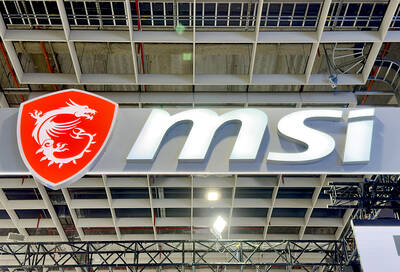Advanced Micro Devices Inc (AMD) is in advanced discussions to buy Xilinx Inc in a takeover that could be valued at US$30 billion, according to people familiar with the matter.
The deal could come together as early as next week, although it remains in flux, the people said, asking not to be identified discussing a private deal. The Wall Street Journal first reported on the negotiations.
A combination with Xilinx would give AMD chief executive officer Lisa Su (蘇姿丰) more of the pieces needed to break Intel Corp’s stranglehold on the profitable market for data-center computer components.
It would follow moves by rival Nvidia Corp, which bought Mellanox Technologies Ltd and aims to use its pending acquisition of Arm Ltd to grab more of that business.
Acquiring Xilinx, which makes programmable chips for wireless networks, would also help AMD expand into a new market just as telecommunications carriers spend billions to build 5G networks.
Xilinx, based in San Jose, California, makes field programmable gate arrays (FPGAs), which are unique because their functions can be altered by software, even after they have been installed in a piece of machinery.
Xilinx’s chips have historically been used in telecommunications equipment, but under CEO Victor Peng the company is expanding into products targeted at data centers — where FPGAs can be used to accelerate workloads such as artificial intelligence.
The other major supplier of advanced FPGAs is Intel, which acquired its market position through the purchase of Altera Corp in 2015.
Representatives for AMD and Xilinx declined to comment.
Xilinx shares closed at US$105.99 in New York on Thursday, giving it a market capitalization of US$25.9 billion, about a quarter of AMD’s value.
Shares of Santa Clara, California-based AMD closed at US$86.51. The stock has almost doubled this year.
Under Su, who took the helm in 2014, AMD has surged back from the brink of failure. It has made gains against longtime rival Intel in desktop computer processors and laptops.
The company is also working to reverse its fortunes in the server business, where chips can cost as much as a small car. For years, Intel had relegated AMD to less than 1 percent of that market.
AMD’s interest in Xilinx reflects the increasing demands of cloud-services providers such as Amazon.com Inc and Alphabet Inc’s Google.
Those companies are spending heavily on new data centers to meet the surge in demand for computing power delivered through the Internet.
They are also racing to enhance services, such as search, with artificial intelligence software, and many companies are experimenting with building their own hardware to do so. That is putting greater pressure on chip providers to advance their offerings.
For AMD investors, how the company intends to finance the deal might prove crucial in persuading them to sign off. The chipmaker has only recently shed concerns about its cash reserves and was haunted by debt incurred from a takeover of graphics chipmaker ATI Technologies in 2006.
At the end of its most-recent quarter, AMD had cash and equivalents of US$1.8 billion, less than several other chipmakers.
Nvidia is using stock to partially fund its purchase of Arm. Analog Devices Inc’s acquisition of Maxim Integrated Products Inc is an all-stock deal. That partly reflects a huge run-up in the value of chip companies in the past few years, led by AMD and Nvidia.
Xilinx shares have not rallied as much. The stock is up 8 percent this year compared with a gain of 27 percent by the Philadelphia Stock Exchange Semiconductor Index.
AMD has surged nearly 90 percent, making it the second-best performer behind Nvidia.
The approval of chip-industry transactions has been complicated by an ongoing trade dispute between China and the US. China is the biggest purchaser of chips, while the US is home to the biggest group of producers.

DIVIDED VIEWS: Although the Fed agreed on holding rates steady, some officials see no rate cuts for this year, while 10 policymakers foresee two or more cuts There are a lot of unknowns about the outlook for the economy and interest rates, but US Federal Reserve Chair Jerome Powell signaled at least one thing seems certain: Higher prices are coming. Fed policymakers voted unanimously to hold interest rates steady at a range of 4.25 percent to 4.50 percent for a fourth straight meeting on Wednesday, as they await clarity on whether tariffs would leave a one-time or more lasting mark on inflation. Powell said it is still unclear how much of the bill would fall on the shoulders of consumers, but he expects to learn more about tariffs

Meta Platforms Inc offered US$100 million bonuses to OpenAI employees in an unsuccessful bid to poach the ChatGPT maker’s talent and strengthen its own generative artificial intelligence (AI) teams, OpenAI CEO Sam Altman has said. Facebook’s parent company — a competitor of OpenAI — also offered “giant” annual salaries exceeding US$100 million to OpenAI staffers, Altman said in an interview on the Uncapped with Jack Altman podcast released on Tuesday. “It is crazy,” Sam Altman told his brother Jack in the interview. “I’m really happy that at least so far none of our best people have decided to take them

PLANS: MSI is also planning to upgrade its service center in the Netherlands Micro-Star International Co (MSI, 微星) yesterday said it plans to set up a server assembly line at its Poland service center this year at the earliest. The computer and peripherals manufacturer expects that the new server assembly line would shorten transportation times in shipments to European countries, a company spokesperson told the Taipei Times by telephone. MSI manufactures motherboards, graphics cards, notebook computers, servers, optical storage devices and communication devices. The company operates plants in Taiwan and China, and runs a global network of service centers. The company is also considering upgrading its service center in the Netherlands into a

NOT JUSTIFIED: The bank’s governor said there would only be a rate cut if inflation falls below 1.5% and economic conditions deteriorate, which have not been detected The central bank yesterday kept its key interest rates unchanged for a fifth consecutive quarter, aligning with market expectations, while slightly lowering its inflation outlook amid signs of cooling price pressures. The move came after the US Federal Reserve held rates steady overnight, despite pressure from US President Donald Trump to cut borrowing costs. Central bank board members unanimously voted to maintain the discount rate at 2 percent, the secured loan rate at 2.375 percent and the overnight lending rate at 4.25 percent. “We consider the policy decision appropriate, although it suggests tightening leaning after factoring in slackening inflation and stable GDP growth,”